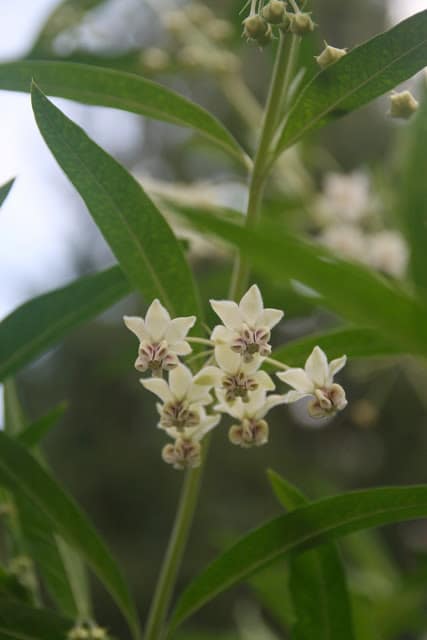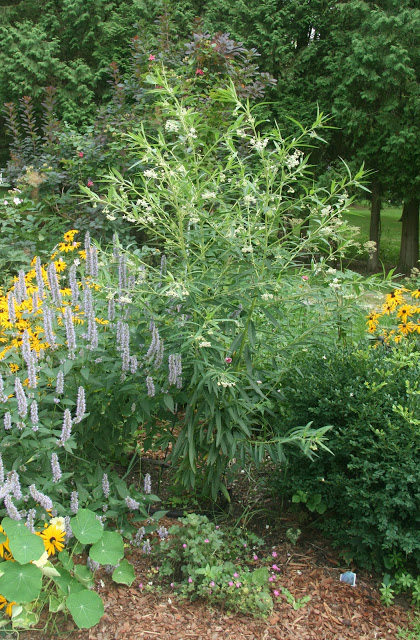As part of embracing that philosophy, this spring I bought a plant for no reason other than that I thought it was funny. I actually first saw this plant in New Zealand and I’ve been searching for it ever since. It’s Asclepias physocarpa but its common name—Family Jewels tree (aka Hairy Balls plant, or the far more boring Balloonplant) says far more about what this member of the milkweed family actually looks like.
It’s a tender perennial in zone 7, so it is most certainly an annual in my zone 5b garden, but I wanted to give it a shot anyway. It first started flowering a couple weeks ago so I was worried that I wouldn’t get to see any of the seed pods that give it its common names. Never fear, the family jewels are here.
 |
| It’s OK, you can giggle. You know you want to. |
There are several seed pods now and they are growing rather rapidly (obviously I’m not watering it with cold water 😉 ) but I’m really enjoying this plant for its form as well. It has an elongated leaf that isn’t unlike what you’d find on an olive tree. I absolutely love olive trees because I think they are just so pretty. I hate olives though. Go figure. Anyway, it’s difficult to find an elongated, slightly blueish leaf on a plant that will grow in northern climates so this was a nice surprise.
 |
| The flowers are diminutive but pretty with a lovely light scent. |
 |
| The plant stands about 5 feet 6 inches tall and has a sort of free-form habit. I like it. |
I’m going to try to save a few of the seeds and grow this from seed next year. Any plant that makes me laugh every time I see it is certainly one worth growing. Even if it means that you have a rather juvenile sense of humor.
P.S. I think I should receive some sort of award for keeps the puns to a minimum in this post. Feel free to add as many as you like in the comments though. If you have the cojones.
What would you like to know? Search, or jump to categories below.
17 Responses
Hi Erin, Thanks for such a great blog which I've been enjoying heaps here in NZ. I'm pretty sure these are Swan Plants. If you're interested, google that name and you'll find they are beloved by Monarch caterpillars and lots of kiwis grow them especially to help increase the butterflies population. If you squint and imagine very hard the seed pods do look a bit like a swan. But … hairy balls is hysterical (never heard them called that over here) and how on earth do I put that out of my mind … oh no, think that's what they will end up being called at my farm from now on!
I'm so glad you've been enjoying the blog! You're right, they are also called Swan plants (almost as boring as Balloonplant and certainly not nearly as fun as the Hairy Balls plant!) I've not seen one caterpillar on mine, but they say they do love them (as they should seeing as how it's part of the milkweed family). So happy to hear this plant will have a new name on your farm! If I remember correctly I first saw this plant growing over a fence in Russell while we were on a sailing charter up in the Bay of Islands. Obviously it stuck with me!
Okay I squinted and I can't see a swan. Hairy Balls it is!! Too funny really. But a striking plant nonetheless. Your name game brought back to mind that SNL sketch with Alec Baldwin – Schweady Balls. Remember?
We saw this at Olbrich a couple of years ago and definitely guffawed! Really cool plant and you are so right about finding blue plants for our climate.
Just found your post while looking up Hairy Ball Plant. I need to send this link to several people who are questioning my sanity after I sent them pictures of this plant in my garden and told them the name. My garden club really cracked up over this and we are not 13 years old – more like over 60!
I'm glad you found the post. I still think it's the funniest plant I've ever had in the garden. It's also quite pretty. Unfortunately I had a horrible aphid problem with it so I opted not to plant it again this year. Here's the post on the aphids: https://www.theimpatientgardener.com/2012/09/ok-thats-just-gross.html
My Family Jewels is doing so well here in San Jose (drought and all!). I was looking up how to treat it in the winter and came across your blog. If you (or any of your readers) know what I am supposed to do with it over the cooler months (do I trim it back to the stem, leave it alone, cut it short???) I would love more information as I am really proud of my balls!! (I am 42, but I do teach high school art so I am juvenile at best!).
I appreciate any insight.
Is it self pollinating?
Is it self pollinating?
Hi there,
I believe you said the Hairy Balls tree is an annual. Does that mean that it will die? My tree was doing so well and then in a matter of two weeks, it looks dead:( We did notice some aphids on it, but I don't think the aphids killed the tree. Do you have suggestions or ideas of what we should do. We leave in San Diego and this dyeing of the tree happened in early August.
I should have been more specific: In my zone (5) it's an annual, but it is hardy in zones 7 to 10, which San Diego would be in. Not sure why yours would have died, but its supposed to be a self-sower, so you might get lucky with that. Here's a link to information on it that might help: https://www.anniesannuals.com/plants/view/?id=122
This plant was a volunteer. When I saw the cluster of what?, turned out to be the little flowers you described, then the spiky balls began to grin along the stem half way up the plant. I was trying to find the name through many different wordings of descriptions. Finally I searched picture of spiky balls and whst came up was: Balloon. Milkweed, hairy balls. That was it exactly. I live I Oakland, CA. I’ve since read more on this plant and find there are different types. It’s an exotic plant for sure and attracts butterflies.
I’d like to know how big the seed pod balls get? & do they just.open on their own?
I found some “hairy balls’ in my paddock here in New South Wales, Australia a couple of weeks ago. Hadn’t seen any for many many years. When we were kids in Western Australia we would pick them with the stalk (which became the neck) and floated them on water. We called them the swan plant. As they floated that was just what they looked like. I took the ones I found recently along to a coffee morning with friends. Had them in hysterics when I was showing them the “hairy balls”, also called Bishops Balls. I’m all for anything we can get a laugh out of. Need it these days.
Hello! I just found your blog too. I am in Norther California, I too have a “Hairy Balls” milkweed
going in my yard. The The monarchs visited them but none of the caterpillars would eat any leaves. I know every
different regions have certain milkweed plant that that the
Butterfly’s lay eggs on. Mine went for the milkweed I raised from seed, not the big guy “Family Jewels”!
I wonder why? Thanks for your great blog.Louise
I’ve had no monarch activity on mine either. But lots of neighbor comments. 🙂
I have had these plants in my garden for several years now & the monarch butterflies love it. So many monarch caterpillars that they eat all the leaves on the plant. They’re now just empty sticks with the big balls 😂. I think first year there weren’t many caterpillars so hang in there. Oh and you can collect the seeds (black or very dark brown are ripe) and grow more plants for next year. You just gently squeeze the balls and they pop open when they’re ripe. Oh boy what a funny plant this is. No wonder my friends & kids tease me!!! I live in SF East Bay